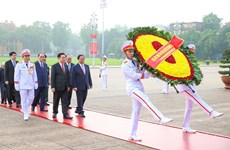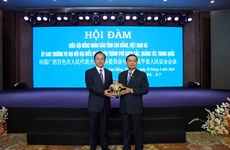East Sea row: China violates int’l, regional commitments
China’s recent illegal action in the East Sea, deep inside in the
exclusive economic zone and continental shelf of Vietnam has violated
international and regional commitments as well as the two countries’
agreements.
On May 2, China stationed its drilling rig Haiyang Shiyou-981 and various ships at 15 degrees 29 minutes 58 seconds north latitude and 111 degrees 12 minutes 06 seconds east longitude. The location is 80 nautical miles deep inside Vietnam’s exclusive economic zone.
On May 2, China stationed its drilling rig Haiyang Shiyou-981 and various ships at 15 degrees 29 minutes 58 seconds north latitude and 111 degrees 12 minutes 06 seconds east longitude. The location is 80 nautical miles deep inside Vietnam’s exclusive economic zone.
China’s recent illegal action in the East Sea, deep inside in the
exclusive economic zone and continental shelf of Vietnam has violated
international and regional commitments as well as the two countries’
agreements.
On May 2, China stationed its drilling rig Haiyang Shiyou-981 and various ships at 15 degrees 29 minutes 58 seconds north latitude and 111 degrees 12 minutes 06 seconds east longitude. The location is 80 nautical miles deep inside Vietnam’s exclusive economic zone.
The move threatens peace, stability, security, safety and maritime freedom in the East Sea.
As a major country in the region and one of the five standing members of the United Nations Security Council, China needs to abide by international law and act as a responsible country for regional peace and security and a responsible partner for international and regional commitments, stated Colonel Vu Khanh, an expert on international relations.
China’s illegal act seriously violates Vietnam’s sovereign right and jurisdiction over its exclusive economic zone and continental shelf. It also runs counter to the 1982 UN Convention on the Law of the Sea (UNCLOS 1982) to which China is a signatory, the Declaration on the Conduct of Parties in the East Sea (DOC) between the Association of Southeast Asian Nations (ASEAN) and China and the agreement on basic principles guiding the settlement of issues at sea between leaders of Vietnam and China.
China’s action impacts on peace, stability, safety and maritime freedom in the East Sea and undermines efforts to strengthen regional political trust and cooperation between the two sides, Khanh stressed.
The UN Convention on the Law of the Sea is the most important international legal document since World War II ended in 1945, the colonel argued. It covers all the most important matters on the legal mechanisms surrounding seas and oceans, satisfying the interests of coastal countries as well as ensuring equality for UN member states.
Article 55 defines that “the exclusive economic zone is an area beyond and adjacent to the territorial sea, subject to the specific legal regime established in this Part, under which the rights and jurisdiction of the coastal State and the rights and freedoms of other States are governed by the relevant provisions of this Convention.”
In Article 56, the convention says that in the exclusive economic zone, the coastal State has “sovereign rights for the purpose of exploring and exploiting, conserving and managing the natural resources, whether living or non-living, of the waters superjacent to the seabed and of the seabed and its subsoil, and with regard to other activities for the economic exploitation and exploration of the zone, such as the production of energy from the water, currents and winds”.
Article 76 says that the continental shelf of a coastal State comprises the seabed and subsoil of the submarine areas that extend beyond its territorial sea throughout the natural prolongation of its land territory to the outer edge of the continental margin, or to a distance of 200 nautical miles from the baselines from which the breadth of the territorial sea is measured where the outer edge of the continental margin does not extend up to that distance.
According to Article 77, the coastal State exercises over the continental shelf sovereign rights for the purpose of exploring it and exploiting its natural resources. The rights are exclusive in the sense that if the coastal State does not explore the continental shelf or exploit its natural resources, no one may undertake these activities without the express consent of the coastal State.
China’s deployment of its rig at a location south of Tri Ton Island, which belongs to the Hoang Sa (Paracel) archipelago of Vietnam, seriously violates fundamental principles, sovereign right and jurisdiction of Vietnam prescribed in the UNCLOS 1982. It’s clear that China infringed Vietnam’s jurisdiction as it stationed the rig without Vietnam’s permission.
It is regrettable that China “forgot” its responsibility as a signatory to the DOC inked in Phnom Penh, Cambodia, on November 4, 2002. While pending a code of conduct (COC), a more legally binding document, the DOC, remains a turning point in the East Sea issue.
Since reaching the DOC, China has conducted a number of actions raising worries to other countries such as claims on sovereignty over the East Sea, maritime resources exploitation and surveillance activities to affirm its sovereignty and increasing naval forces and military games in the East Sea.
Despite Vietnam’s protest and the condemnation of many countries against China’s nine-dash line map and actions in the East Sea, the neighbour has stepped up its military operations, complicating the situation in the sea area. The placement of its rig Haiyang Shiyou-981 is a new step of escalation to realise its nine-dash line claim, turning the East Sea into its territorial waters that China has taken.
Nevertheless, China goes against the agreement on basic principles guiding the settlement of issues at sea signed by the two countries’ leaders in 2011.
Accordingly, the two sides agreed to be patient to satisfactorily solve issues at sea through amicable negotiations to build the East Sea into a sea of peace, friendship and cooperation, contributing to maintaining peace and stability in the region. Problems arising are also settled in the spirit of respect to full legal evidence plus the consideration of other related elements such as history, while referring to rational concerns of each other with a constructive attitude, looking towards the expansion of common perception and narrowing differences and unceasingly promoting the negotiation process.
In face of China’s brazen actions, Vietnam has so far kept its restraint and advocates solving all disputes peacefully.
Vietnam demanded China immediately withdraw its rig and surrounding vessels from the exclusive economic zone and continental shelf of Vietnam, and not recur similar activities in the future.-VNA
On May 2, China stationed its drilling rig Haiyang Shiyou-981 and various ships at 15 degrees 29 minutes 58 seconds north latitude and 111 degrees 12 minutes 06 seconds east longitude. The location is 80 nautical miles deep inside Vietnam’s exclusive economic zone.
The move threatens peace, stability, security, safety and maritime freedom in the East Sea.
As a major country in the region and one of the five standing members of the United Nations Security Council, China needs to abide by international law and act as a responsible country for regional peace and security and a responsible partner for international and regional commitments, stated Colonel Vu Khanh, an expert on international relations.
China’s illegal act seriously violates Vietnam’s sovereign right and jurisdiction over its exclusive economic zone and continental shelf. It also runs counter to the 1982 UN Convention on the Law of the Sea (UNCLOS 1982) to which China is a signatory, the Declaration on the Conduct of Parties in the East Sea (DOC) between the Association of Southeast Asian Nations (ASEAN) and China and the agreement on basic principles guiding the settlement of issues at sea between leaders of Vietnam and China.
China’s action impacts on peace, stability, safety and maritime freedom in the East Sea and undermines efforts to strengthen regional political trust and cooperation between the two sides, Khanh stressed.
The UN Convention on the Law of the Sea is the most important international legal document since World War II ended in 1945, the colonel argued. It covers all the most important matters on the legal mechanisms surrounding seas and oceans, satisfying the interests of coastal countries as well as ensuring equality for UN member states.
Article 55 defines that “the exclusive economic zone is an area beyond and adjacent to the territorial sea, subject to the specific legal regime established in this Part, under which the rights and jurisdiction of the coastal State and the rights and freedoms of other States are governed by the relevant provisions of this Convention.”
In Article 56, the convention says that in the exclusive economic zone, the coastal State has “sovereign rights for the purpose of exploring and exploiting, conserving and managing the natural resources, whether living or non-living, of the waters superjacent to the seabed and of the seabed and its subsoil, and with regard to other activities for the economic exploitation and exploration of the zone, such as the production of energy from the water, currents and winds”.
Article 76 says that the continental shelf of a coastal State comprises the seabed and subsoil of the submarine areas that extend beyond its territorial sea throughout the natural prolongation of its land territory to the outer edge of the continental margin, or to a distance of 200 nautical miles from the baselines from which the breadth of the territorial sea is measured where the outer edge of the continental margin does not extend up to that distance.
According to Article 77, the coastal State exercises over the continental shelf sovereign rights for the purpose of exploring it and exploiting its natural resources. The rights are exclusive in the sense that if the coastal State does not explore the continental shelf or exploit its natural resources, no one may undertake these activities without the express consent of the coastal State.
China’s deployment of its rig at a location south of Tri Ton Island, which belongs to the Hoang Sa (Paracel) archipelago of Vietnam, seriously violates fundamental principles, sovereign right and jurisdiction of Vietnam prescribed in the UNCLOS 1982. It’s clear that China infringed Vietnam’s jurisdiction as it stationed the rig without Vietnam’s permission.
It is regrettable that China “forgot” its responsibility as a signatory to the DOC inked in Phnom Penh, Cambodia, on November 4, 2002. While pending a code of conduct (COC), a more legally binding document, the DOC, remains a turning point in the East Sea issue.
Since reaching the DOC, China has conducted a number of actions raising worries to other countries such as claims on sovereignty over the East Sea, maritime resources exploitation and surveillance activities to affirm its sovereignty and increasing naval forces and military games in the East Sea.
Despite Vietnam’s protest and the condemnation of many countries against China’s nine-dash line map and actions in the East Sea, the neighbour has stepped up its military operations, complicating the situation in the sea area. The placement of its rig Haiyang Shiyou-981 is a new step of escalation to realise its nine-dash line claim, turning the East Sea into its territorial waters that China has taken.
Nevertheless, China goes against the agreement on basic principles guiding the settlement of issues at sea signed by the two countries’ leaders in 2011.
Accordingly, the two sides agreed to be patient to satisfactorily solve issues at sea through amicable negotiations to build the East Sea into a sea of peace, friendship and cooperation, contributing to maintaining peace and stability in the region. Problems arising are also settled in the spirit of respect to full legal evidence plus the consideration of other related elements such as history, while referring to rational concerns of each other with a constructive attitude, looking towards the expansion of common perception and narrowing differences and unceasingly promoting the negotiation process.
In face of China’s brazen actions, Vietnam has so far kept its restraint and advocates solving all disputes peacefully.
Vietnam demanded China immediately withdraw its rig and surrounding vessels from the exclusive economic zone and continental shelf of Vietnam, and not recur similar activities in the future.-VNA













